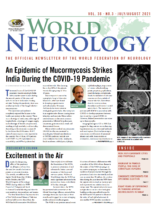By Satish Khadilkar and Sarosh Katrak
 The COVID pandemic had universal effects on medicine, and Mumbai was no exception. In fact, being a densely populated city with lots of international travelers, the cases appeared early and the magnitude was high, throwing the health system off gear.
The COVID pandemic had universal effects on medicine, and Mumbai was no exception. In fact, being a densely populated city with lots of international travelers, the cases appeared early and the magnitude was high, throwing the health system off gear.
While most of the younger neurologists continued to work, they had to be involved with COVID duties as well. The focus shifted to service medicine and service neurology in a major way, and academic activities had to take a back seat.
The AAN-WFN Continuum Program has been operational in Mumbai since 2005, initiated by S. M. Katrak as per the advice given by Ted Munsat. The first event was held at Mumbai on
July 17, 2005, on multiple sclerosis and was attended by postgraduate students from five institutions. Following the success of the program at Mumbai, teachers in other cities of India also conducted Continuums in their cities, and the programs were well regarded by students and practitioners.
Satish Khadilkar had attended the programs since the beginning and participated more actively in the later years, taking up the responsibility as co-convenor of the program with Katrak’s guidance and advice, and as convenor since 2021.
Virtual platforms gradually developed, and the government opened up online consultations in 2020. We decided to shift to an online platform for this CME program. Having worked with physical copies of Continuum and in-person meetings, it was a challenge to acclimatize to this form of learning.
Interestingly, it did not prove too difficult, particularly for younger colleagues. We conducted the first online Continuum program Dec. 27, 2020, on the topic of neurocritical care. It was attended by 48 participants.
In 2021, we have conducted programs on dementia, epilepsy, and demyelinating disorders, which were attended by approximately 50-85 students from various institutions in Mumbai, other places in the state of Maharashtra, and a few from the state of Gujrat. We incorporated the Google forms for virtual feedback. All participants do not complete the forms, and we are exploring ways to facilitate the process.
We have recently adopted a system wherein a mentor helps the presenter to prepare his slides. This approach has much increased the clarity and utility of the presentations, time management, homogeneity of the group, and the individuals find themselves more involved. We intend to persist with this pattern and are in discussion with other centers in India to adopt this method in their centers for these Continuum programs. •
